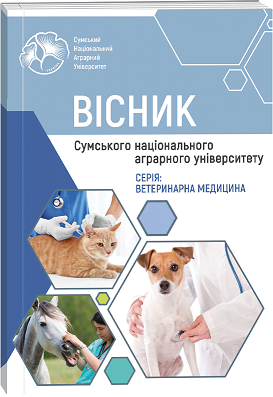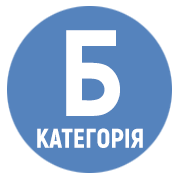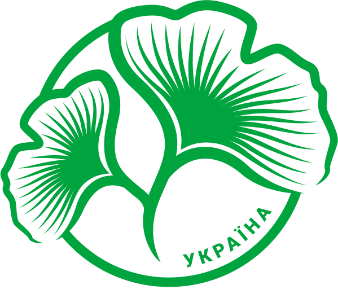RESISTANCE OF THE RABBIT ORGANISM AND THE QUALITY OF RABBIT FRESH UNDER THE CONDITIONS OF SUPPLY
Abstract
The conducted research allows us to assert the positive effect of feeding rabbit feed additives during the period of laying on the body's resistance and obtaining high-quality meat and fur. It was established that already on the 5th day of introduction of feed additives "Chika" and "Ushastyk" into the diet of animals according to the research scheme increases the resistance of the organism, although not all indicators have a reliable characteristic. In the animals of the experimental groups, the content of lysozyme in the blood increased by 1.07-1.08 times, complement – unlikely, properdin by 1.20 times, IgG, mg/ml by 1.12 times. Feeding the guinea pigs with fodder until the 10th day of gestation by females fixed the increase in the activity of resistance factors. In the animals of the experimental groups, the content of lysozyme in the blood increased by 1.15-1.18 times, complement – by 1.15 times, and properdin by 1.16 times compared to the control – 1.15 times (p ≤0.05), Ig G, mg/ml in 1.39 times (p ≤0.01). LASK and BASK had a tendency to increase, but in the animals of the experimental groups they were not likely to be higher. The completeness of phagocytosis was significantly increased by 1.15 (p ≤0.05), and the phagocytosis index by 1.27 times in animals of the fourth group (p ≤0.01), by 1.09 times in animals of the third group (p ≤0, 05). The introduction of feed additives into the diet of rabbits until the end of the fruit-bearing period preserved a high level of activity of indicators of the body's natural resistance. In the animals of the experimental groups, the content of lysozyme in the blood increased in comparison with the control by 1.25-1.19 times (p ≤0.05), complement by 1.06-1.07 times, properdin by 1.23-1, 25 times for the second and third groups (p ≤0.05), Ig G, mg/ml in 1.69 times in the third group (р ≤0.01). Providing animals with feed additives in the following made it possible to obtain high-quality products from rabbits. We found that the content of total moisture in the meat of animals of the control group was 73.999± 2.066%, which was 1.243% more than in the meat of animals of the second group. In the meat of animals of the third and fourth groups, the moisture content was significantly lower, which was accompanied by an increase in the content of dry matter in the meat. The content of dry matter in meat from animals of the control group was 1.396, 1.55 and 1.56% less than in meat from animals of the second – fourth group. The highest level of fur characteristics is determined in skins obtained from animals of the 4th group. The fur on the skins obtained from experimental animals is the most formed. The arrangement of collagen fibers in bundles is thinner and denser. The number of hairs in the skin cover is on average 5800 thousand more pieces per cm2. Skins from animals of the 4th group are more long-haired, thick-haired, with a higher density of skin tissue.
References
2. Bandurka, N.M (2014). Rol membrannykh lipidiv u mekhanizmakh ionnoho transportu – fiziolohichni ta patolohichni aspekty. [The role of membrane lipids in ion transport mechanisms – physiological and pathological aspects.] Biomedical and biosocial anthropology, 23, 263-269. [in Ukrainain]
3. Bashchenko, M.I., Honchar, O.F., Shevchenko, Ye.A. (2011). Krolivnytstvo. [Rabbit breeding.]: Cherkasy Institute of Agricultural Research, 302 p. [in Ukrainain]
4. Bevzo, V.V (2017). Nefermentatyvna antyoksydantna systema krovi ta pechinky shchuriv za umovy tryvaloho vvedennia hlutamatu natriiu. [Non-enzymatic antioxidant system of blood and liver of rats under the condition of long-term administration of monosodium glutamate.] Bulletin of the Ukrainian Medical Dental Academy, 1, 213-217. [in Ukrainain]
5. Bielenichev, I.F; Levytskyi, Ye.L., Kovalenko, S.I. (2002). Antyoksydantna systema zakhystu orhanizmu. [Antioxidant system of organism protection.] Modern problems of toxicology, 3, 29-31. [in Ukrainain]
6. Borovikova, Ye.I.; Yuskiv, I.D. (2014). Stan systemy antyoksydantnoho zakhystu kroliv za umovy spontannoho psoroptozu v litnii period roku. [State of antioxidant system of rabbits under the condition of spontaneous psoroptosis in the summer period of the year.] Scientific Bulletin of the SZ. Gzhytskyi LNUVMBT, 65-71. [in Ukrainain]
7. Darmohrai, L.M., Luchyn, I.S. (2015). Kontseptualni zasady intensyvnoho vyrobnytstva kroliatyny ta shliakhy realizatsii. [Conceptual principles of intensive rabbit meat production and ways of implementation.] Electronic newsletter. Agroforum Bulletin, 8, 27-32. [in Ukrainain]
8. Darmohrai, L.N., Shevchenko, M.Ie., Luchyn, I.S. (2015). Peretravnist pozhyvnykh rechovyn i retentsiia azotu v kroliv za riznoi kilkosti drizhdzhiv u ratsioni. [Nutrient digestibility and nitrogen retention in rabbits with different amounts of yeast in the diet.] Animal Biology, 4, 55-60. [in Ukrainain]
9. Ibatullin, I. I., Chychyk, R.M., Panasenko, Yu.O. (2005). Produktyvnist molodniaku kroliv pry zghodovuvanni povnoratsionnykh kombikormiv z riznym rivnem proteinu. [Productivity of young rabbits when fed complete compound feeds with different protein levels.] Scientific Bulletin of LNUVMBT named after S. Z.Gzhytskogo, 3, 45-58. [in Ukrainain]
10. Ivanytska, A.I., Lesyk, Ya.V., Tsap, M.M. (2017). Vplyv spoluk sylitsiiu na imunofiziolohichnu raektyvnist orhanizmu kroliv [The influence of silicon compounds on the immunophysiological reactivity of the rabbit organism]. Animal Biology 3, p. 42-49. [in Ukrainain]
11. Kosianenko, O.M. (2010). Peretravnist kormu ta produktyvnist molodniaku kroliv za riznykh dzherel selenu v ratsioni [Digestibility of feed and productivity of young rabbits with different sources of selenium in the diet.] Collection of scientific works of Vinnytsia National Agrarian University. Series: Agricultural Sciences, 4, pp. 78-81. [in Ukrainain]
12. Kostiuk, S.S. (2014). Vplyv hama-oprominennia na aktyvnist fermentiv antyoksydantnoi systemy kroliv. [The effect of gamma irradiation on the activity of enzymes of the antioxidant system of rabbits. Collection of scientific works of Kharkiv National Pedagogical University named after G.S. Skovoroda] Biology and Valeology, 16, 16-20. [in Ukrainain]
13. Kotelevych, V.A., Fedotov, S.V. (2007). Shchodo korysnosti kroliatynydlia naselennia u zminenykh ekolohichnykh umovakh Poliskoho rehionu. [On the usefulness of rabbit meat for the population in changed ecological conditions of the Polesie region.] Visn. of the State Agroecological University, 2, 30-33. [in Ukrainain]
14. Kotsiubenko, H. (2011). Oderzhannia ekolohichnoi kroliatyny : smachno i vyhidno. [Obtaining ecological rabbit meat: tasty and profitable]. Food Industry of the Agricultural and Industrial Complex, 5, 29-32. [in Ukrainain]
15. Kotsiubenko, H.A. (2017). Naukovo-praktychni metody pidvyshchennia produktyvnosti kroliv: monohrafiia [Scientific and practical methods for increasing the productivity of rabbits:] monograph G.A. Kotsiubenko. – Mykolaiv: MNAU, 191 p. [in Ukrainain]
16. Kytaieva, A.P., Mikhelson, H.A., Kotsiubenko A. P. (2011). Tekhnolohiia vyrobnytstva produktsii klitkovoho khutrovoho zvirivnytstva. [Technology of production of caged fur products. Odesa: Drukarskyi dom, 336 p. [in Ukrainain]
17. Linnik V.S., Medvedev, V.H., Prudnikov Yu. A. (2013). Teoretychni ta praktychni osnovy tekhnolohii vyrobnytstva produktsii tvarynnytstva [Theoretical and practical foundations of livestock production technologies] – Lugansk, 239 p. [in Ukrainain]
18. Sirenko N. M. (2008). Sotsialna funktsiia innovatsiinoi modeli rozvytku ahropromyslovoho vyrobnytstva [Social function of an innovative model of development of agro-industrial product]. Economics of the Agricultural and Industrial Complex, 4., 50-54. [in Ukrainain]
19. Vakulenko, I.S., Poladian, Z. (2006). Efektyvnist krolivnytstva na riznykh fermakh. Efficiency of rabbit farming on different farms] Livestock of Ukraine, 5, 27-29. [in Ukrainain]
20. Vlasenko, N.O. (2013). Vmist hlutationu v erytrotsytakh i kistkovomu mozku tvaryn pry zastosuvanni meksydolu za umov hostroho stresu [Glutathione content in erythrocytes and bone marrow of animals when using mexidol under conditions of acute stress] Zaporozhye Medical Journal, 2, 10-13 [in Ukrainain]
21. Vlizlo, V.V. Fedoruk, R.S., Ratych, I.B. (2012). Laboratorni metody doslidzhen u biolohii, tvarynnytstvi ta veterynarnii medytsyni. [Laboratory methods of research in biology, animal husbandry and veterinary medicine. Lviv, 762 p. [in Ukrainain]
22. Voronkova, Yu.S., Holoborodko, K.K., Marenkov, O.V., Horban, V.A. (2016). Problema doslidzhennia oksydatyvnoho stresu u biolohichnykh doslidzhenniakh. [The problem of studying oxidative stress in biological studies] Issues of bioindication and biology, 1-2, 222-.229. [in Ukrainain]

 ISSN
ISSN  ISSN
ISSN 



